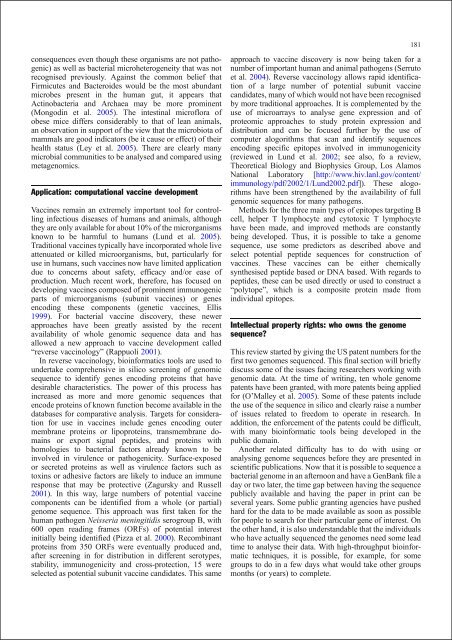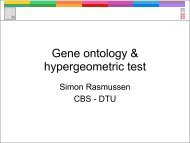Computational tools and Interoperability in Comparative ... - CBS
Computational tools and Interoperability in Comparative ... - CBS
Computational tools and Interoperability in Comparative ... - CBS
You also want an ePaper? Increase the reach of your titles
YUMPU automatically turns print PDFs into web optimized ePapers that Google loves.
consequences even though these organisms are not pathogenic)<br />
as well as bacterial microheterogeneity that was not<br />
recognised previously. Aga<strong>in</strong>st the common belief that<br />
Firmicutes <strong>and</strong> Bacteroides would be the most abundant<br />
microbes present <strong>in</strong> the human gut, it appears that<br />
Act<strong>in</strong>obacteria <strong>and</strong> Archaea may be more prom<strong>in</strong>ent<br />
(Mongod<strong>in</strong> et al. 2005). The <strong>in</strong>test<strong>in</strong>al microflora of<br />
obese mice differs considerably to that of lean animals,<br />
an observation <strong>in</strong> support of the view that the microbiota of<br />
mammals are good <strong>in</strong>dicators (be it cause or effect) of their<br />
health status (Ley et al. 2005). There are clearly many<br />
microbial communities to be analysed <strong>and</strong> compared us<strong>in</strong>g<br />
metagenomics.<br />
Application: computational vacc<strong>in</strong>e development<br />
Vacc<strong>in</strong>es rema<strong>in</strong> an extremely important tool for controll<strong>in</strong>g<br />
<strong>in</strong>fectious diseases of humans <strong>and</strong> animals, although<br />
they are only available for about 10% of the microrganisms<br />
known to be harmful to humans (Lund et al. 2005).<br />
Traditional vacc<strong>in</strong>es typically have <strong>in</strong>corporated whole live<br />
attenuated or killed microorganisms, but, particularly for<br />
use <strong>in</strong> humans, such vacc<strong>in</strong>es now have limited application<br />
due to concerns about safety, efficacy <strong>and</strong>/or ease of<br />
production. Much recent work, therefore, has focused on<br />
develop<strong>in</strong>g vacc<strong>in</strong>es composed of prom<strong>in</strong>ent immunogenic<br />
parts of microorganisms (subunit vacc<strong>in</strong>es) or genes<br />
encod<strong>in</strong>g these components (genetic vacc<strong>in</strong>es, Ellis<br />
1999). For bacterial vacc<strong>in</strong>e discovery, these newer<br />
approaches have been greatly assisted by the recent<br />
availability of whole genomic sequence data <strong>and</strong> has<br />
allowed a new approach to vacc<strong>in</strong>e development called<br />
“reverse vacc<strong>in</strong>ology” (Rappuoli 2001).<br />
In reverse vacc<strong>in</strong>ology, bio<strong>in</strong>formatics <strong>tools</strong> are used to<br />
undertake comprehensive <strong>in</strong> silico screen<strong>in</strong>g of genomic<br />
sequence to identify genes encod<strong>in</strong>g prote<strong>in</strong>s that have<br />
desirable characteristics. The power of this process has<br />
<strong>in</strong>creased as more <strong>and</strong> more genomic sequences that<br />
encode prote<strong>in</strong>s of known function become available <strong>in</strong> the<br />
databases for comparative analysis. Targets for consideration<br />
for use <strong>in</strong> vacc<strong>in</strong>es <strong>in</strong>clude genes encod<strong>in</strong>g outer<br />
membrane prote<strong>in</strong>s or lipoprote<strong>in</strong>s, transmembrane doma<strong>in</strong>s<br />
or export signal peptides, <strong>and</strong> prote<strong>in</strong>s with<br />
homologies to bacterial factors already known to be<br />
<strong>in</strong>volved <strong>in</strong> virulence or pathogenicity. Surface-exposed<br />
or secreted prote<strong>in</strong>s as well as virulence factors such as<br />
tox<strong>in</strong>s or adhesive factors are likely to <strong>in</strong>duce an immune<br />
response that may be protective (Zagursky <strong>and</strong> Russell<br />
2001). In this way, large numbers of potential vacc<strong>in</strong>e<br />
components can be identified from a whole (or partial)<br />
genome sequence. This approach was first taken for the<br />
human pathogen Neisseria men<strong>in</strong>gitidis serogroup B, with<br />
600 open read<strong>in</strong>g frames (ORFs) of potential <strong>in</strong>terest<br />
<strong>in</strong>itially be<strong>in</strong>g identified (Pizza et al. 2000). Recomb<strong>in</strong>ant<br />
prote<strong>in</strong>s from 350 ORFs were eventually produced <strong>and</strong>,<br />
after screen<strong>in</strong>g <strong>in</strong> for distribution <strong>in</strong> different serotypes,<br />
stability, immunogenicity <strong>and</strong> cross-protection, 15 were<br />
selected as potential subunit vacc<strong>in</strong>e c<strong>and</strong>idates. This same<br />
approach to vacc<strong>in</strong>e discovery is now be<strong>in</strong>g taken for a<br />
number of important human <strong>and</strong> animal pathogens (Serruto<br />
et al. 2004). Reverse vacc<strong>in</strong>ology allows rapid identification<br />
of a large number of potential subunit vacc<strong>in</strong>e<br />
c<strong>and</strong>idates, many of which would not have been recognised<br />
by more traditional approaches. It is complemented by the<br />
use of microarrays to analyse gene expression <strong>and</strong> of<br />
proteomic approaches to study prote<strong>in</strong> expression <strong>and</strong><br />
distribution <strong>and</strong> can be focused further by the use of<br />
computer alogorithms that scan <strong>and</strong> identify sequences<br />
encod<strong>in</strong>g specific epitopes <strong>in</strong>volved <strong>in</strong> immunogenicity<br />
(reviewed <strong>in</strong> Lund et al. 2002; see also, fo a review,<br />
Theoretical Biology <strong>and</strong> Biophysics Group, Los Alamos<br />
National Laboratory [http://www.hiv.lanl.gov/content/<br />
immunology/pdf/2002/1/Lund2002.pdf]). These alogorithms<br />
have been strengthened by the availability of full<br />
genomic sequences for many pathogens.<br />
Methods for the three ma<strong>in</strong> types of epitopes target<strong>in</strong>g B<br />
cell, helper T lymphocyte <strong>and</strong> cytotoxic T lymphocyte<br />
have been made, <strong>and</strong> improved methods are constantly<br />
be<strong>in</strong>g developed. Thus, it is possible to take a genome<br />
sequence, use some predictors as described above <strong>and</strong><br />
select potential peptide sequences for construction of<br />
vacc<strong>in</strong>es. These vacc<strong>in</strong>es can be either chemically<br />
synthesised peptide based or DNA based. With regards to<br />
peptides, these can be used directly or used to construct a<br />
“polytope”, which is a composite prote<strong>in</strong> made from<br />
<strong>in</strong>dividual epitopes.<br />
Intellectual property rights: who owns the genome<br />
sequence?<br />
181<br />
This review started by giv<strong>in</strong>g the US patent numbers for the<br />
first two genomes sequenced. This f<strong>in</strong>al section will briefly<br />
discuss some of the issues fac<strong>in</strong>g researchers work<strong>in</strong>g with<br />
genomic data. At the time of writ<strong>in</strong>g, ten whole genome<br />
patents have been granted, with more patents be<strong>in</strong>g applied<br />
for (O’Malley et al. 2005). Some of these patents <strong>in</strong>clude<br />
the use of the sequence <strong>in</strong> silico <strong>and</strong> clearly raise a number<br />
of issues related to freedom to operate <strong>in</strong> research. In<br />
addition, the enforcement of the patents could be difficult,<br />
with many bio<strong>in</strong>formatic <strong>tools</strong> be<strong>in</strong>g developed <strong>in</strong> the<br />
public doma<strong>in</strong>.<br />
Another related difficulty has to do with us<strong>in</strong>g or<br />
analys<strong>in</strong>g genome sequences before they are presented <strong>in</strong><br />
scientific publications. Now that it is possible to sequence a<br />
bacterial genome <strong>in</strong> an afternoon <strong>and</strong> have a GenBank file a<br />
day or two later, the time gap between hav<strong>in</strong>g the sequence<br />
publicly available <strong>and</strong> hav<strong>in</strong>g the paper <strong>in</strong> pr<strong>in</strong>t can be<br />
several years. Some public grant<strong>in</strong>g agencies have pushed<br />
hard for the data to be made available as soon as possible<br />
for people to search for their particular gene of <strong>in</strong>terest. On<br />
the other h<strong>and</strong>, it is also underst<strong>and</strong>able that the <strong>in</strong>dividuals<br />
who have actually sequenced the genomes need some lead<br />
time to analyse their data. With high-throughput bio<strong>in</strong>formatic<br />
techniques, it is possible, for example, for some<br />
groups to do <strong>in</strong> a few days what would take other groups<br />
months (or years) to complete.









